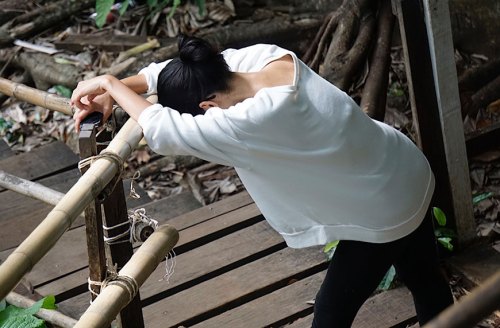If you’ve spent one too many days going from sitting in one place (your desk) to another (the couch), you may have been left with a case of weak glutes. It doesn’t take as long as you may think to lose strength and muscular endurance. And, like many things, you don’t know how good you have it until that glute strength is gone.
Experts in This Article
Nashville-based certified personal trainer and fitness instructor
physical therapist at ATI Physical Therapy
physical therapist, strength and conditioning specialist, and Pilates and barre instructor
vice president of programming and education at BFT
The good news? Whether you’re dealing with weak glutes from a sedentary lifestyle or a lack of hitting the gym, there are some strength training exercises you can do to build your gluteal muscles back up again.
What are the glutes and why are strong glutes important?
Our gluteal muscles quite literally power us through everything we do.
“Having strong glutes can really make all the difference in your day-to-day life,” says physical therapist Laurence Agénor, PT, DPT.
The glutes are composed of three muscles—the gluteus maximus, gluteus medius, and gluteus minimus—”each of which is responsible for producing or assisting with a particular motion at the hip joint,” she says (and also why strong glutes are key for hip stability).
It’s incredibly important to prioritize glute strength because it plays a role in so many different aspects of your life, according to Dr. Agénor.
“Building or maintaining strength in this particular group of muscles can help to alleviate pain, as well as improve your functional capacity and quality of life,” she says. “Strong gluteus medius and minimus muscles, for example, could mean less knee pain with stairs. Strong gluteus maximus muscles can aid with propulsion if you’re running to catch the bus or trying to keep up with your children.”
What causes weak glutes?
If you’re wondering what causes weak glutes in the first place, there’s one primary culprit: a sedentary lifestyle.
When we spend most of our days sitting—hello, extra-long work days—losing muscle strength isn’t uncommon. Over time, that leads to glute weakness.
“If you have a sedentary occupation—which 80 percent of people do—you can guarantee that your glutes are underactive,” Steve Stonehouse, CPT, certified personal trainer, previously told Well+Good. The more time we spend in a seated position, the more difficult it is for the gluteal muscles to turn back on.
Of course, there are plenty of ways you can combat a sedentary lifestyle to ensure you’re keeping your glutes in top-notch shape. For instance, doing weak glutes exercises and walking to build glutes can help activate and strengthen the muscle group. But if you’re asking yourself what weak glutes look like in the first place, there are some red flags to be aware of that will let you know there’s a problem.
Telltale symptoms of weak glutes
Now that you know what causes weak glutes, you may be curious about the weak glutes symptoms that let you know intervention is needed. Here are a few telltale signs that will make you want to add some strength training exercises to your routine, pronto.
1. Bad posture
There are plenty of reasons for bad posture—working slouched over on the couch for hours at a time, included. But poor posture is also an under-the-radar weak glutes symptom.
“Decreased strength in the glutes can alter your optimal postural alignment and the pelvis’ position in standing or when exercising,” Dr. Agénor says.
2. Pain in your low back or pelvic area
Oftentimes, lower back pain is associated with a weak core. Something most people don’t realize, though, is that your core is more than your abdominal muscles.
“Your core is made up of several muscles, including your glutes,” Dr. Agénor says. The whole shebang needs to be strong and stable to support our everyday functions.
When it comes to what muscles overcompensate for weak glutes, the back muscles are among those at the top of the list. So it’s no surprise that one of the most common weak glutes symptoms is pain in your low back or SI (sacroiliac) joint, which connects your lumbar spine to your pelvis, Dr. Agénor explains. If your backside isn’t strong enough to keep everything in place, that muscle imbalance could cause you to wind up with a hyper-arched low back, “potentially causing a feeling of compression and pain in the lumbopelvic region.”.
Your lumbo-pelvic-hip complex (LPHC) is another name for your core, and it contains dozens of muscles and bones in and around your pelvis, hips, and lumbar spine. It supports your upper and lower body, so any weak link in this chain can cause disruptions above or below. That’s why fixing glute imbalance the second you notice it is so important.
3. Having a hard time with stairs
What do weak glutes look like? If you want the ultimate weak glutes test, take the stairs and see how you feel. It’s one of the best ways to check for glute activation and strength.
Seeing as your butt muscles work like an elevator, helping you lift and lower yourself up stairs or hills, having trouble with this action is a clue that you have weak glutes.
“With stronger glutes, you may notice less pain and discomfort going up and down the stairs,” Dr. Agénor says. With weak glutes, the opposite is true.
4. Feeling fatigued from standing briefly
Because part of what causes weak glutes is a sedentary lifestyle, another easy weak glutes test is seeing if you often feel fatigued from standing.
Sitting for prolonged periods of time can lead to dead butt syndrome, aka gluteal amnesia. If you’re wondering what weak glutes look like, this can manifest as numbness in the glutes, or a feeling of wobbliness as you try to stand up, Dallas Reynolds, DPT, COMT, a physical therapist at ATI Physical Therapy in Illinois, previously told Well+Good.
“If walking prolonged distances or standing for longer than 10 minutes causes discomfort in the low back or SI joint region, strengthening the glutes can also be helpful in alleviating this type of pain,” Dr. Agénor says.
How to strengthen weak glutes: 5 corrective exercises to try
There’s no ifs, ands, or buts about it: The best way to address weak glutes and any muscle imbalance you’re dealing with is through strength training and working the best glute exercises into your routine.
“Some of my go-to exercises to strengthen the glutes are bridges, step-ups, reverse lunges, and side-lying hip exercises such as hydrants and leg lifts,” Dr. Agénor says. “I sometimes incorporate a side plank in with the side-lying exercises to further strengthen the core.” You can also add in some upper glute exercises like clamshells.
Remember, your butt is the base of your core, and it’s connected to your abs and back by various connective tissues, tendons, and muscular structures.
“Not only are these glute exercises challenging, but they help with function,” Dr. Agénor says. “These exercises are also a wonderful opportunity to activate your transverse abdominis, one of your deep core stabilizers, which will ultimately provide more support to your lumbopelvic region.”
Below, kickstart your weak glutes treatment plan by trying some of her go-to exercises for glute activation. (Pro tip: When you don’t have time for a full-on sweat sesh, you can always sneak in some glute exercises while working.)
1. Glute bridge
- 1.Start lying on the mat with your knees bent and feet flat on the ground hip-width apart. Rest your arms by your sides.
- 2.Squeeze your glutes and core, and press your heels into the ground to drive your hips up toward the ceiling.
- 3.Once your body is in a straight line, lower back down to the floor.
- 4.Do 3 sets of 12 reps.
2. Reverse lunge
- 1.Stand with your feet together. You should be at a slight forward lean with your shoulders rolled back and your core tight.
- 2.Take a step backward with your right foot, lowering your body toward the floor until both legs are bent at 90-degree angles.
- 3.When your right knee reaches the floor, press back up to standing.
- 4.Do 12 reps then repeat on the opposite side.
3. Step-up
- 1.Stand in front of a step bench or a bottom stair.
- 2.Step onto the platform with your right foot, followed by your left.
- 3.Bring your right foot back down to the floor, followed by your left.
- 4.Do 12 reps then repeat with your left foot leading.
- 5.Want a challenge? You can also add knee-ups, taps, and other variations into the mix.
4. Fire hydrant
- 1.Start in a tabletop position on the mat.
- 2.Lift your right leg to the side until your knee is in line with your hip.
- 3.Lower your leg back down to your starting position.
- 4.Do 12 reps then repeat on the opposite side.
5. Clamshell
- 1.Lie on your side with bent knees, evenly stacked hip bones, and your side waist slightly lifted.
- 2.Keeping your heels together, lift your top knee toward the ceiling, then lower it back down.
- 3.Do 12 reps then repeat on the opposite side.
FAQ
1. How do you test for weak glutes?
An easy weak glutes test to start with is to take the stairs and see how you feel. If you’re having trouble—or are experiencing pain or discomfort—moving up and down the stairs, it’s a good indicator that you should add weak glutes exercises into your routine. Another option is to do a standing test. If standing for longer than 10 minutes leaves you with pain or discomfort in your low back, you may need to start up a weak glutes treatment plan.
2. What are symptoms of weak glutes?
Other muscles overcompensate for weak glutes. This oftentimes occurs with the low back, which is why one of the most common weak glutes symptoms is experiencing pain in the area. Aside from dealing with pain and discomfort from glute muscle imbalances, other signs of weak glutes include balance issues (as your glutes impact hip stability) and poor posture. If you’re experiencing any of these symptoms, it’s important to start doing glute exercises on a regular basis to build up your strength.
3. Which exercise is best for glutes?
There are numerous weak glutes exercises that can help strengthen the muscle group. Dr. Agénor says building up your strength doesn’t need to be complicated; you can start with some easy-to-follow options that are great for glute activation, such as bridges, reverse lunges, step-ups, clamshells, and fire hydrants.
4. How long does it take to strengthen weak glutes?
Glutes not growing as fast as you’d like? If you’re wondering how long it takes to strengthen weak glutes, it’s not an overnight thing. However, with a good weak glutes treatment plan that involves doing glute activation exercises regularly, you’ll start feeling stronger in as little as a few months—not to mention notice other benefits, too, like improved hip stability and balance.
Aim to exercise for 20 to 30 minutes, two or three days a week, to grow your glute muscles, according to the Mayo Clinic. Don’t just focus on your glutes, either—work on building full-body strength. This won’t just leave you feeling stronger now, but will also benefit you down the line.
“The work is never over and consistency always gives you the possibility to expedite that process,” Bianca Vesco, CPT, a Nashville-based certified personal trainer, previously told Well+Good. “However, training for life is a lifelong journey and taking care of your glutes and overall leg strength is a surefire way to make sure you’re still strong and able-bodied at 80 years old. Strong glutes, strong legs, strong life.”
Sign Up for Our Daily Newsletter
Get all the latest in wellness, trends, food, fitness, beauty, and more delivered right to your inbox.
Got it, you've been added to our email list.










